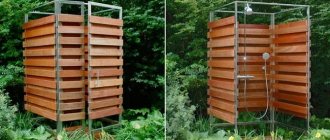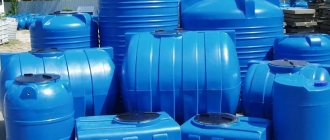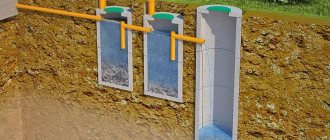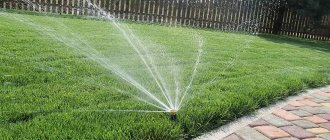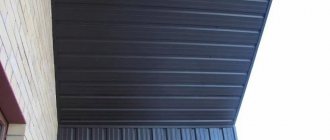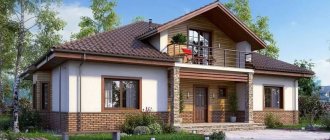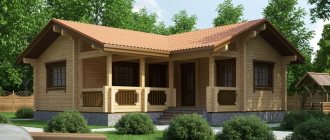A concrete septic tank is a concrete structure in which sewage is collected and treated. Depending on the complexity of the septic tank structure, the wastewater from it can be pumped out or undergo several stages of purification. The main purpose of the pit is to prevent soil contamination by chemicals contained in wastewater.
For a septic tank, ready-made concrete containers made according to one template can be used Source prostroyer.ru
A full-fledged multi-chamber septic tank consists of several compartments in which the stages of waste treatment occur:
- Compartment for primary accumulation of sewage water. This department receives wastewater from the house and is divided into elements heavier and lighter than water and primary clarification liquid. If the structure of the septic tank is single-chamber and does not provide for further waste treatment, then the collected wastewater is simply pumped out periodically.
- Oxygen-free compartment. The lack of oxygen promotes the proliferation of anaerobic organisms. In the process of vital activity, they decompose complex substances into simple ones: fats, carbohydrates and household chemicals into gas, water and sludge.
- Oxygen compartment. In this section, microorganisms process substances that subsequently settle at the bottom.
- Water drainage. After all stages of purification, wastewater, clarified by approximately 70%, is discharged for soil post-treatment into a filtration field, from where it goes into the soil.
Construction of a concrete septic tank
This structure is erected from concrete rings. It is better to entrust the installation of such a sump to specialists. Failure to comply with technology can lead to consequences. It is better to divide the pit into several compartments, which will be connected by pipes.
Types of septic tanks:
- Single chamber
- Double chamber
- Three-chamber
The first type is a regular pit in which wastewater is simply collected. Waste is pumped out approximately once every 6 months. Proper operation will allow you to use septic tanks for many years.
Two- and three-chamber systems have a filter well with a monolithic bottom. Water is discharged through a drainage pipe. In such septic tanks, the water is purified better, since the well is not contaminated with solid particles.
A multi-chamber septic tank uses anaerobic bacteria that purify wastewater naturally Source remontik.org
Septon
Septic tank "Septon" - new for 2022! Serves 3-15 people. The station provides deep wastewater treatment thanks to bacteria contained in a separate block of the station for up to three months without the entry of organic matter. The model range of septic tanks without pumping is attractive with a variety of options with different capacities, volume of volley discharges, and insertion depth of the supply pipe. The “Smart” module (crushed stone-free drainage system) is optional.
Technological solutions for the best septic tank in 2022
The Septon septic tank is made of homogeneous integrally foamed copolymer (polypropylene + ethylene) and can withstand operating temperatures of +40...-40˚С. The body is represented by a self-supporting cylindrical vessel equipped with a rectangular lid. The neck and lid are painted green. The round shape, one weld seam ensures long-term operation of the septic tank - 25 years. The product has minimal dimensions, occupying 2 m2 of area.
The wastewater is treated biologically using suspended activated sludge. Air is supplied by a membrane tubular polymer aerator. Nitrogen compounds are best removed during general biological treatment. Forced drainage systems are equipped with a built-in storage tank with a drainage pump. The liquid is disinfected with a built-in ultraviolet disinfectant. The GSM system (sold separately) notifies about changes in the operation of the septic tank and simplifies management.
The septic tank operates without noise, odor, and does not require pumping. The degree of wastewater recycling reaches 98%. Conversion of a gravity structure into a forced one is allowed. The absence of fragile parts prevents mechanical breakdowns.
Principle of aerobic biological action
Septon Smart septic tanks for private homes can withstand uneven flow of wastewater, operate effectively at low loads, and support the vital activity of bacteria during large burst discharges, eliminating the washout of microflora. Biological treatment, accompanied by oxidation with oxygen, reduces the BOD and allows clean water to be discharged without filtration fields.
Aerobic-anoxic wastewater processing allows activated sludge to absorb organic and chemical compounds in the presence or absence of dissolved oxygen. The sludge mass, incubated from bacterial strains supplied along with organic waste, forms colonies of bacteria in the form of flakes that are easily separated from clean water. Airlifts, which circulate the liquid with compressed air bubbles, help prevent the destruction of activated sludge flakes.
Contents of delivery
Basic modifications of Septon septic tanks without pumping include a housing, a compressor, a technical passport, and a 110x15° outlet pipe.
Forced drainage systems are additionally equipped with a storage tank, a good drainage pump with a float switch, a reinforced PVC hose, fittings and connectors.
Model range of VOC "Septon" for a private home
The Septon line includes septic tanks of gravity, forced type (PR), extended modifications “Long” (the entrance height is increased by 40 cm, the body length is increased by 50 cm). The numbers in the marking indicate the volume of salvo discharge. Technical characteristics of Septon allow you to choose the best solution for a private home or cottage:
200 SAM, PR - inlet tube depth 60 cm, number of users 3-4, peak discharge 200 l, daily productivity 0.6 m3. Dimensions: 85x85x228 cm, energy consumption 1 kW/knock.
250 SAM, PR - inlet pipe height 60 cm, 4-5 consumers, one-time water supply 250 l, capacity 0.8 m3. Dimensions of a popular modification for a private home: 90x90x228 cm, energy consumption 1.2 kW.
320 SAM, PR, Long - pipe insertion height 90 cm, recommended number of residents 5-6, one-time discharge 320 l. Minimum dimensions: 100x100x250 cm, best energy consumption - 1.6 kW.
500 SAM, PR, Long - connection of the pipe at a height of 90 cm, users - 7...8, one-time supply of liquid - 500 l. Basic parameters: 112x112x250 cm, electricity - 2 kW.
800 SAM, PR, Long - insertion height - 90 cm, consumers - 9...10, peak discharge - 800 l, standard tank dimensions: 155x155x250 cm, capacity 1.8 m3/day, energy consumption - 2.6 kW.
1000 SAM, PR, Long - connection depth 90 cm, residents of a private house - 15, capacity 3 m3/day. Basic parameters: 177x177x250 cm. Power consumption of a septic tank without pumping is 3.1 kW.
Price range: 77-180 thousand rubles.
With a water consumption of 200 l/day per resident of a private house, the septic tank completely processes waste within the established limits. Sludge is pumped out every 3-6 months. When concluding a service agreement, the manufacturer provides 2 free technical services and provides a 5-year warranty.
Construction of a single-chamber septic tank
This type of sump consists of a pit in which walls are made of concrete rings or cast-in-place concrete. The bottom should be monolithic or consist of layers of sand and gravel. Water enters the pit, and after two days the heavy elements settle to the bottom. Gases exit through a special hole, and water is pumped out. Silt forms at the bottom, which is removed with a special pump. The size of the drainage pit depends on the number of people living in the house. The disadvantage of such a septic tank is its rapid filling.
A septic tank with one chamber usually requires pumping out wastewater with special equipment Source moya-banya.ru
See also: Catalog of companies that specialize in water supply and sewerage.
Model selection
The choice of tank volume, number of chambers and operating principle of a septic tank for a summer residence and for a home largely depends on operating conditions. The functionality of a treatment facility at a dacha, where people come for a few hours or days, differs from how a septic tank works in a private house with a shower, kitchen, toilet and water-consuming household appliances (washing machines, dishwashers, etc.).
In a house with permanent residence, not only is the volume of wastewater larger, but its composition is also more complex, which includes both organic and chemically active substances. In this case, it is important to ensure the possibility of high-quality cleaning for drainage into the ground, so that you do not have to constantly call a sewer truck. Investment in the purchase of an effective aerobic energy-dependent septic tank and the costs of its operation in this case will pay off. But during breaks in operation at a summer cottage, bacteria can die.
We talked about what products are available for septic tanks and cesspools in another article. Features of the use of chemical and biological drugs.
You will learn how to make a wastewater treatment plant from Eurocubes yourself by reading this article.
You will find a review of models of peat country toilets here https://okanalizacii.ru/postrojki/tualet/torfyanoj-tualet-dlya-dachi-kakoj-vybrat.html
Construction of a two-chamber concrete septic tank
This structure consists of two compartments. The first section receives sewage water from the house. Heavy waste settles at the bottom, and water and foam flow through the pipe into the second section. The bottom of the chambers must be monolithic. In the second compartment you can cover the bottom with crushed stone. The advantage of such a septic tank is that heavy particles remain at the bottom of the first chamber.
The purified liquid from the second chamber goes into the ground Source sv.decorexpro.com
Three-chamber concrete septic tank
The installation of such a sewer requires a lot of labor and material costs. It is better to arrange it in a private house where people permanently live. The first section of the septic tank serves to settle the wastewater. Bacteria break down solid particles into simpler ones. Water flows through the connecting pipe into the second section. There, the compressor periodically supplies oxygen, which promotes the proliferation of aerobic microorganisms. Further wastewater treatment takes place. In the last chamber, the water goes through the final stage of purification. Using a pump, it is forcibly discharged into the drainage system.
The scheme of a three-chamber septic tank is the most complex and requires high costs Source masterseptika.ru
Volume of the future septic tank
The service life of the tank depends on the correctly calculated volume. If there are several chambers, only the volume of the first is calculated. The remaining volumes of the chambers are taken depending on the displacement of the receiving compartment. Daily water consumption is taken as a basis. In this case, this number is increased three times. The next chamber should be half the size of the first. It receives water purified from heavy organic substances.
The number of rings is calculated by dividing the volume of the entire container by the volume of the ring itself. It is worth considering that there are several sizes of concrete rings for septic tanks on the building materials market. After counting the number of rings, it is easy to determine the volume of concrete mixture required.
The larger the volume of the septic tank, the less often it requires cleaning the wells Source prostroyer.ru
Septic system design
First of all, the specialist must determine the groundwater level. This will be the required depth at which the septic tank is installed. Then excavation work is carried out.
Excavation
Their implementation can be done manually or mechanized. The walls of the pit must be smooth and compacted so that when concreting them there is no spillage of soil. At the same time, pipes are installed to drain water into the soil. The depth of laying pipes should not be lower than the freezing level of the soil. If this condition cannot be met, the pipeline must be insulated.
A polyethylene film is laid on the bottom of the pit. It serves as additional insulation and reduces the consumption of concrete mixture. It is better to lay the film in several layers.
Regardless of the shape and size of the future septic tank, the walls of the pit must be smooth and dense Source beton-house.com
Construction and installation of a country septic tank from monolithic concrete with your own hands
When performing concrete work during the construction of a septic tank for a summer residence, you need to use a site plan and a diagram of the internal structure of the tank (number of sections and installation order).
Sequence of installation work:
- We mark the supply trenches and pit. The boundary of the area for the tank should be 200 mm larger than the dimensions of the tank.
- We carry out earthworks. The trench under the supply pipe is dug with a slope to the horizontal surface of at least 2%. A sand bedding 150 mm thick is made along the bottom of the excavation.
- We are preparing reinforcement mesh and formwork panels.
- Along the bottom of the pit we arrange a crushed stone-sand cushion 150-200 mm high.
- We lay the reinforcement frame on the prepared site, and install the formwork around the perimeter under the bottom of the septic tank.
- We make a concrete mixture or, if the volume allows, we take a ready-made one.
- We lay the solution.
- We compact the layer with a vibrator.
- We wait 72 hours and remove the formwork.
- On the bottom of the tank we mark the diagram of future walls and partitions. The thickness of the walls is 200 mm, the thickness of the bulkheads is 150 mm.
- According to this plan: we arrange the panels for the walls and lay the reinforcement frame inside. The height of the fence should be no more than 1 m. In this case, it will be convenient to compact the mixture with an internal vibrator. Don’t forget to place steel or plastic sleeves in the formwork under the inlet and outlet pipes, and leave holes in the partitions for overflow and ventilation.
- Pour the mixture into the structure.
- We give time to the concrete to gain the necessary strength and move the formwork up to the next section.
- Laying the mortar continues until the walls reach the design mark.
- To cover the septic tank, you can use a prefabricated reinforced concrete slab with an already equipped hole for the hatch or continue laying monolithic concrete in the same sequence as pouring the solution into the main part of the structure.
- Upon completion of installation work, we install underwater and outlet pipes, equip a ventilation duct and waterproof the walls and ceilings.
- We backfill the pit. The soil is laid in layers (200-350 mm) with mandatory compaction using special devices.
Tips for use
- Do not throw garbage and solid household waste into drain pipes;
- Do not drain hot water, which will kill germs in the drain hole;
- Timely cleaning will extend the life of the septic tank;
- Do not repair the sewer system yourself.
The operation of a concrete septic tank involves not only draining the waste, but also cleaning the pipes, maintaining a sufficient number of microorganisms in the septic tank compartments and timely cleaning the pit from solids.
You need to try to use less chemicals in order to prevent corrosion of the monolith of the walls and bottom. In order to save water consumption, purified water can be used to water the garden.
Rules for placing an ecoseptic tank for a summer residence
Before purchasing a septic tank for your dacha/cottage, you need to decide on its location. This must be done in advance, since the containers for the septic tank are quite impressive in size. In addition, the treatment facility must be located on the site in accordance with established standards and regulations. The latter are set out in the documents - SNiP 2.04.03-85, 2.04.02-84 and 2.04.01-85, SanPiN 2.1.5.980-00 and 2.2.1/2.1.1.1200-03. They can be found freely available on the Internet and studied if necessary.
The regulations governing the installation of a septic tank were not developed by chance. Any septic tank is a potential environmental threat, which consists of the following:
- Possible flooding of the foundations of buildings and structures due to broken tightness of pipe connections or the tank itself.
- Contamination of the site, contamination of soil and water with E. coli and other bacteria in the event of a septic tank overflow. This happens with a sharp increase in groundwater level in the spring, melting of snow and ice, or prolonged autumn rains. Or due to untimely cleaning of the container.
- Ingress of microbial environment and liquid waste into open reservoirs or sources of drinking water, wells, wells.
- Distribution of unpleasant odors throughout the site and indoors.
- Infection of the fertile soil layer with bacteria, death of plants, shrubs, and fruit trees.
When choosing a place for an ecoseptic tank, you need to adhere to the following rules:
- A distance of at least 5 meters must be maintained from the septic tank to the foundation of a residential building. There must be at least 1 meter to other outbuildings. Sometimes you can reduce the distance from the septic tank to the house. This is possible when the septic tank is a closed type with complete biological processing of waste. But this point also requires additional approval.
- The distance of the septic tank from the water source is important. If the well is filled from the upper aquifers, then the distance from the septic tank to it must be at least 50 meters. For light soils, such as sand, the distance increases to 80 meters. When the source of water is a deep water intake well, the distance is maintained at least 25 m. But, if the topography of the site allows it, it is better to install the septic tank lower down the slope. This will reduce the likelihood of runoff entering aquifers.
Determining the exact distance is necessary using calculations. For each site, the calculation must be performed individually. The basis is based on soil studies and the relationship between aquifers and filter layers.
- Water pipes should be located at a distance of 10 meters from the septic tank.
- The distance from the septic tank to a standing body of water (pond, lake) must be at least 30 meters. From a stream or river - 10 meters.
- When the house is located near a highway with busy traffic, the minimum distance from it should be at least 5 meters.
- You should not plant shrubs or trees closer than 3 meters around the septic tank. Firstly, tree roots can damage the integrity of the hull. Secondly, shrubs and trees can become saturated with excess organic matter and harmful bacteria, become intoxicated and die.
- There must be at least 2 meters from the border of the neighboring plot to the septic tank. In addition, it is important to follow all the rules described above in relation to the neighboring plot and its outbuildings, plantings, etc. To avoid problems, it is important to agree on the location of the septic tank with the neighbors in advance.
Based on the listed requirements, it is clear that choosing the optimal location for a septic tank for a summer residence is not so easy. In addition to the above rules, it is necessary to provide a place for the entry of a sewage disposal truck to ensure regular cleaning of the septic tank.
If the optimal location has been selected, this does not mean that installation can begin. First of all, the installation of a structure such as a septic tank requires drawing up a project. It must be approved by the local sanitary and epidemiological service office. Specialists are required to conduct soil studies and take into account the terrain features in order to accurately determine the required distance to other objects.
It is important to strictly adhere to the design during installation. In cases where any problems arise during operation, an inspection is scheduled. If during the inspection a certain “independence” in actions is discovered, administrative punishment will follow.
